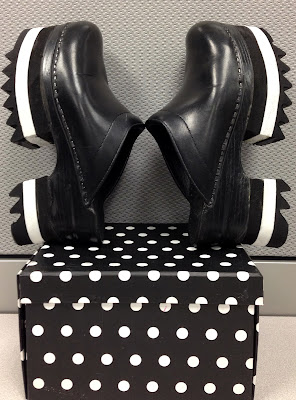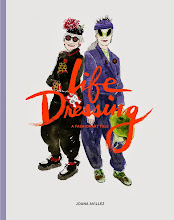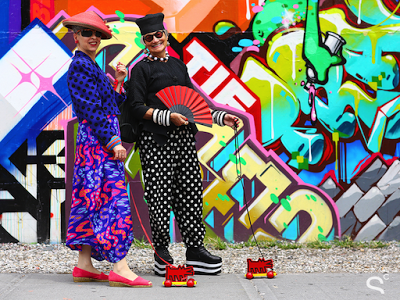It's true that one thing leads to another. At Coterie in February, Fern from the boutique
Rosebud at Koos told us - in glowing language - that we had to visit
the American Folk Art Museum to see the exhibition of folk art reimagined as couture. The Museum invited thirteen designers to look through one hundred preselected items to use as a source of inspiration, and then to come up with original designs based on the art work. At a time when the bottom line and fleeting trends are significant factors in fashion, it was wonderful to see designers let loose like children after school. The show - Folk Couture: Fashion and Folk Art - runs through April 23, 2014.
As you look up at the high ceilinged and well lit entrance to the exhibition, you see Ronaldus Shamask's soaring contributions: three serapes - the black paper kite serape top, made of paper with cardboard buttons; the serape dress, made of iridescent Lurex/nylon with plastic buttons; and the long serape dress, made of linen/silk organza with hand beading.
Shamask chose this drawing called Blue Jacket by James Castle as his starting point and took off in several different directions from there. For a look at the three serapes on earthbound mannequins, scroll down through Studio International's article,
here, and for a full explanation of Shamask's collaboration with the Museum, click
here.

The Museum astutely collected a variety of the draft work of the designers and pinned it to this board near the entrance so visitors could see a bit of the creative process in action. (There were also two video screens showing aspects of the physical work involved.) At top center left of the board is a miniature version of Gary Graham's coat; to the left of it is a very detailed pattern. (Double click on the photo to enlarge!) To the right of that is a swatch for the threeASFOUR dress, and diagonally below that a swatch and drawing for John Bartlett's long green quilted pants. Along the right are drawings for Ronaldus Shamask's three serapes, and at bottom center Michael Bastian's designs for incorporating the Museum's tin top hat, angel Gabriel weathervane, and a wooden sculpture of a nattily dressed man. Each designer was given free rein to create work according to their own concept. Interestingly, carte blanche raised unusual questions among the designers. Some asked if the design had to be wearable. Others were perplexed at the thought of designing without their particular customer base in mind. Unbound by the usual strictures imposed by the market, however, it's clear that the designers took advantage of the opportunity to let their imaginations run wild.

Yeohlee Teng chose four wooden folk sculptures - a coyote, a jackalope, a dog and a ram, then photographed them, printed the photographs on Kraft paper, and stitched the photographs to the dress, which she called
Shamanistic Printed Prayer Flag Dress of Brown Kraft Paper. For more photographs, and a more thorough and very interesting explanation of Teng's creative process, which is as mathematical as it is pictorial, click
here.
This dog was one of four carvings Teng chose.
Design group threeASFOUR consists of three designers of very different backgrounds: Gabi Asfour from Lebanon, Angela Donhauser from Tajikistan, and Adi Gil from Israel. Taking the Friendship Star Quilt seen here for their design, they made a dress of three layers of laser-cut patent leather. Each layer is cut with a Christian (four pointed), an Islamic (five pointed) or a Jewish (six pointed) star. The Star of David, at the time the Friendship Star Quilt was made in the 19th century, was not a Jewish symbol, and the quilt itself was made by Quakers as a sign of friendship, so the design skilfully links themes of religion and peaceful co-existence.
A better view of the laser cut patent leather.
A close-up of one of the stars in the quilt. Each star had a different beautifully detailed central figure. If you'd like to see more about this piece and its designers, click
here.
Fabio Costa took two pieces from the Museum's collection, combined them and reinterpreted them. Behind the mannequin, the central piece of the wood sculpture is the Sacred Heart of Jesus. Costa combined that with the Tree of Life Whitework Quilt (next photo) and created an entire white suit, including hat, visor, blouse, skirt and leggings. Costa's airy gossamer fabrics are listed as "hand quilted nylon, raw silk mesh, cotton fiber, Japanese raw silk yarn and Japanese bamboo yarn".
;+sacred+heart+of+Jesus;+Folk+Couture++Idiosyncratic+Fashionistas+IMG_3406.jpg)
At the center bottom of the quilt, its completion date - 1796 - is rendered in raised stuffwork. While the background of the quilt appears flat in comparison to the raised work, there are small, precise, flat quilting stitches throughout to keep the layers of the quilt from separating, making this a far more complex undertaking than the eye can readily see. Similarly, Costa's work also consists of elaborate stitchwork that is not readily visible. For more photos, and more about Costa's process in making this outfit, click
here.
Gary Graham drew his inspiration from the quilt seen here behind the mannequin, an 1810 American jacquard loomed quilt, with a pattern of blazing stars and snowballs, in indigo-dyed wool and cotton. Retaining the basic design and materials, Graham gives it his own twist by gradating the repeat (which was machine woven at the Rhode Island School of Design) so that it is very large at the hem and becomes much smaller as it rises to the shoulders. The leggings play off the pattern, but are digitally printed cotton and lycra. For more about Graham's creation, click
here.
A close up of the original jacquard weave blazing stars and snowballs.
Bibhu Mohapatra did a surprising reinterpretation of his choice of folk art: a book on tattoo designs.
Instead of recreating the sailor, or his sweetheart, the ship or the book, Mohapatra took two elements from the story he saw in the book, and wove them into a completely new idea. The dress consists primarily of buoyant waves in silk chiffon and organza, and black lace, reminiscent of tattoos on the arms and legs. You can see additional photos and read more about Bibhu's process by clicking
here.
Designer Jean Yu was inspired by a wood and straw New Mexican figurine to create her delicate black chiffon Porcupine dress with the surprising straw adornment dramatically protruding from the back. Ms. Yu was intrigued by the tension between the modern and the primal, the same qualities she ascribes to the porcupine. You want to touch it but can't get too close for fear of triggering its defense mechanism. More on Jean Yu's collaboration with the Museum
here.
Artist Dana Alvarez of Santa Fe, New Mexico created the quite personable Porcupine in 1981.
For her asymmetrical crocheted handkerchief dress, Catherine Malandrino was drawn to the fraternal order of Odd Fellows' values of friendship, love, truth, faith, hope and charity. She used that as her jumping off point for this white (for purity) gown.
The amazingly intricate paper cut of Odd Fellows' symbols made by Joseph C. Heurs dates from 1919.
Chadwick Bell was drawn to an early 19th century bed cover. In his vision, the cornucopia on the quilt embodied the reckless collision of cultural and economic changes and influences in Asia, Europe and the United States in the 19th Century. His dress embodies that confluence in a Greco-Roman-Asian sculpture.
The white cotton bed cover dates from circa 1899 to 1820.
Creatures of the Wind created a dress with a rose and black color combination which captures their signature "outsider" quality and signifies their touchstone, in this case a portrait of a woman in a 1940s-1950s photograph. Using the picture along with black and rose stoneware, the designers made an understated gown with a narrative structure. Their connection with the photographer's work fortuitously predates the exhibition.
Eugene Von Bruenchenhein obsessively produced numerous gelatin and silver prints of his wife Marie from the 1940s to mid-1950s. Posed as a Hollywood pinup, Marie captures a sort of Dorothy Lamour exoticism that helped inspire the Creatures of the Wind. Since Shane Gabier and Christopher Peters were already familiar with photographer von Bruenchenhein's work, it was a great fit. The tight bodice is reminiscent of the strapless dress Marie wears in the photo. The palm fronds loosely resemble the floral print backdrop.
Perhaps the most tongue-in-cheek and yet quite arresting piece in the exhibition is the long quilted jumpsuit created by
John Bartlett, and based on the wonderful late 19th - early 20th century elongated wood carving next to it, "Man with Green Shirt and White Suspenders".
His idea board gives you an idea of the creative process behind the actual production of the garment.
Not surprisingly, the piece that drew from the largest number and widest range of items from the collection was created by the oldest contributor -- Koos van den Akker -- who "paints with fabrics". In his mid-seventies now, the designer came to New York when he was in his late 20s. Trained at Christian Dior, Koos prides himself in the act that he is a craftsman and a tailor and still works regularly at his sewing machine. Five images from the folk art collection were selected (three of which are shown here) and the fabric was specially printed with their likenesses. Then the fabric was sent to India, where sequins were hand-sewn onto the garment.
Justin McCathery's 1968 painting "Industrial Cityscape/Jim Thorpe, PA" was one of the images selected by Koos.
The Vermont artist of this oil on wood, "Woman in Rose Dress", is unidentified but the painting, dated 1805-1815, was also incorporated into the dress pattern.
The 1825 painting, "Woman with Veil", attributed to Emily Eastman, is a haunting visage fitting to be included in Koos' gown.
Although it is a substantial garment, complete with bustle, it is so artfully draped that it looks light and airy, with a lovely bodice. In this part of the exhibition, the color rose is a unifying theme. Visible on the left is Creatures of the Wind's black and rose gown, and on the right is Michael Bastian's outfit against a rose-colored wall. Keep your eye on the 1840 weathervane of the archangel Gabriel, which you'll see was incorporated into the outfit.

American identity looms large in menswear designer Michael Bastian's psyche. He is a lover of folk art and appreciates its sense of humor, fabrics and fit. He drew inspiration for his ensemble from a countertop shop figurine of a man in a suit with a top hat, a 10th Anniversary Tin featuring a top hat and glasses, and a weathervane. Metal influences his design both literally and figuratively. Shiny thread runs through the knit armlets and sweater, which has an image of the weathervane on its chest. The heat is encapsulated in a knit hood, complete with knitted ears. Even the hand-sewn boots have a craftsmanlike theme: They are a collaboration between Bastian and Quoddy, the renowned Maine shoemaker who has been producing footwear since 1909. We loved the Steampunk effect of the whole outfit.
IdiosyncraticFashionstas031514x.jpg)
Everyone is familiar with the designation of the 25th anniversary as "silver" and the 50th as "golden". There are traditional gifts associated with each of the first 15 years of marriage. For example: 1st - paper; 2nd - cotton; 3rd - leather; 4th - linen; 5th - wood; 10th - tin or aluminum; 11th - steel; 12th - silk; 14th - ivory; 15th - crystal. Bastian was inspired by this 10th Anniversary tin in the shape of a top hat and eyeglasses.
"Man in Top Hat with Cane" is attributed to an unidentified artist in the Northeastern United States and dated to around 1840.
At the museum, we met and struck up a conversation with Kim, a graphic designer. She had come to see the exhibit and was specifically interested in the exhibition design by
Situ Studio. She tipped us that the platforms on which the mannequins stand which look like pillows are actually coated in cement. Her insights gave another dimension to the exhibition and our appreciation of it. As she stands next to the John Bartlett piece, you can get a better sense of its three-dimensionality.
It made our day when we met Alexis Carreno, guest curator of the exhibition. Besides being exceptionally talented, he is totally charming and approachable. Despite it's being a Saturday, when one might think a curator had earned a day of rest, we were impressed that he was still actively taking care of things, weeks after the exhibition opened. You can't magine our surprise (and delight) when he came over and introduced himself, saying he knew who we were! Knock us down with a feather! (It's okay to knock us down - we're taking our calcium.)
What we're wearing:
Jean is wearing an Amy Downs hat from her last trunk show; Junya Watanabe for Puma coat from If Soho; Bebe leggings from a 2012 trip to Montreal; Dankso clogs with Jean's's customized DIY black and white platforms; vintage glasses from Fabulous Fanny's; vintage bakelite and gold rings; leather cross-body bag from street vendor.
Valerie is wearing an unlabeled vintage straw hat; Tyvek shirt labeled Mau/Under Construction; H&M bustier; fingerprint ceramic necklace by Peter Lane Clay; felt bracelet from Katinytis on Etsy; Comme des Garcons pants; white leather shoes by Nathalie; unlabeled coat.

































;+sacred+heart+of+Jesus;+Folk+Couture++Idiosyncratic+Fashionistas+IMG_3406.jpg)




IdiosyncraticFashionistas031514x.jpg)
DressIdiosyncraticFashionistas031514x.jpg)
1919(CM)IdiosyncraticFashionistas031514x.jpg)


DressIdiosyncraticFashionistas031415x.jpg)
EugeneVonBruenchenheinGelatinSilverPrintc1940stoMid950sIdiosyncraticFashionistas031514x.jpg)


Idiosyncraticashionistas03151x.jpg)
IdiosyncraticFashionistas031514x.jpg)
WomaninRoseDressVt1805-1815ArtistunidientifiedOilonPineIdiosyncraticFashionistas031514x.jpg)
IdiosyncraticFashionistas031514x.jpg)

IdiosyncraticFashionstas031514x.jpg)
IdiosyncraticFashionistas031514x.jpg)
IdiosyncraticFashionistas031514x.jpg)



